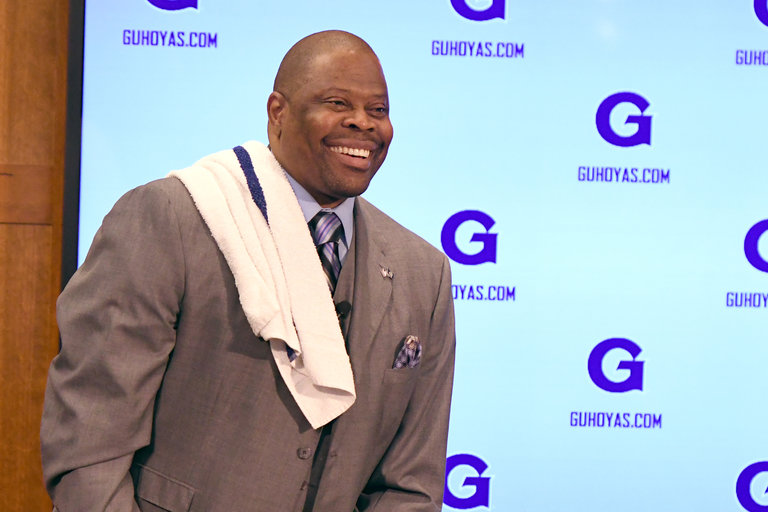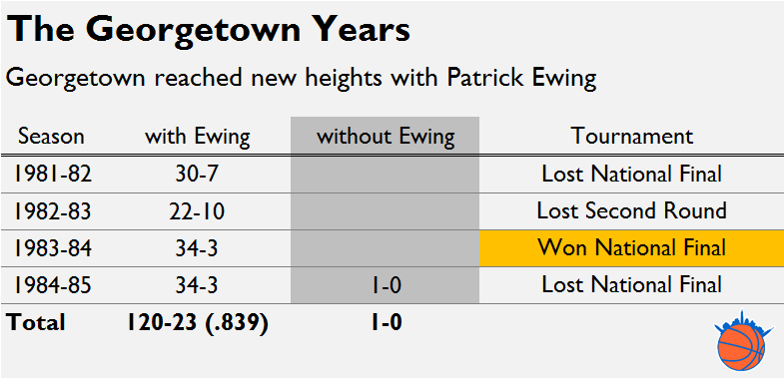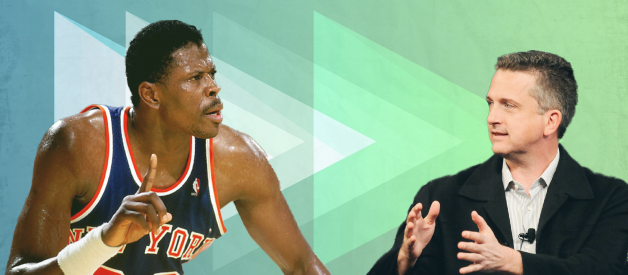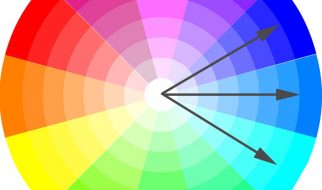Featured
Bill Simmons and his friend famously created the Ewing Theory as an explanation for when teams play better without their star player. But is the theory applicable to the title player?
 Photo: Jeffrey Bellone/TKW Illustration
Photo: Jeffrey Bellone/TKW Illustration
Patrick Ewing turned 55 years old this past week, so it seems like a good time to pay the man some respect and make a plea to Ewing Theory enthusiasts to find a new godfather.
The Ewing Theory was born sometime in the mid-90?s when Bill Simmons? friend, Dave Cirilli, made the observation that Patrick Ewing?s teams (both at Georgetown and in New York) seem to play better without Ewing. A decade-and-a-half later, Simmons wrote about the theory in his ?Sports Guy? column, where he adds details to the theory:
A star athlete receives an inordinate amount of media attention and fan interest, and yet his teams never win anything substantial with him (other than maybe some early-round playoff series).
That same athlete leaves his team (either by injury, trade, graduation, free agency or retirement) ? and both the media and fans immediately write off the team for the following season.
There are two main tenets of the Ewing Theory:
- A team inexplicably plays better when their star player is injured or on the bench.
- A team reaches new heights immediately following the departure of a star player.
These tenets have been proven across all sports ? basketball, baseball, football, hockey. Simmons cites the example of Peyton Manning leaving Tennessee the season before they won a national championship. He also notes the 2000 Mariners making a miraculous playoff run after trading superstars Ken Griffey, Jr., and Randy Johnson.
via The Knicks Wall/SoundCloud
The idea of the Ewing Theory is very real. Knicks fans don?t need to stretch their memories too far in thinking back to their last example of the premise: Linsanity. You know, the madness of Jeremy Lin dropping 20+ point games and the Knicks winning seven games in a row coming on the heels of Amar?e Stoudemire?s and Carmelo Anthony?s inauspicious injuries.
It all makes sense, until you think about the theory?s name, Ewing Theory. Why Patrick Ewing? Did his teams really play better without him? Did they reach new heights after he left?
 Photo: Mitchell Layton/Getty Images
Photo: Mitchell Layton/Getty Images
The mid-90’s was an interesting time for Simmons? friend to have come up with the Ewing Theory, considering up to that point, the only time Patrick Ewing missed extended action due to injury was in his first two seasons in the NBA. During these years, he played for two of the worst teams he would be a part of over his illustrious career. The 1985?86 and 1986?87 Knicks won a combined 47 games. Forget asking whether they played better or worse with Ewing; those teams were like the modern-day Knickerbockers, terrible all of the time. By 1995, Knicks fans were more likely to miss a first-run Friends episode than watch a Knicks game without Patrick Ewing. After playing in 143 of 144 games in college, Ewing missed 10 games out of 745 regular season and playoff affairs between 1988 and 1995.
If Cirilli came up with the Ewing Theory in the mid-90’s and extended the idea back to Ewing?s Georgetown Hoyas days, he must have been using a different set of criteria than what Bill Simmons defined in his column. There is no evidence that Georgetown played better without Ewing, nor did they make a competitive leap when he left for the NBA.
Is Ramon Sessions A Good Defender?
A statistical look at Sessions? impact on defense through video and analytics.
theknickswall.com
I should mention that limited play-by-play data from Ewing?s Georgetown days makes it difficult to analyze how the team fared when he was on the bench for significant chunks of time in foul trouble. Did the Hoyas have a game, or two, when they went on something like a 14?2 run while Ewing was on the bench to overcome a deficit and win a game? Perhaps. But when you consider that Ewing played in roughly 80 percent of the minutes Georgetown played basketball between 1982 and 1985, and only in his freshman season did he not lead the team in minutes played, it seems safe to assume that their unbelievable record during his college career was mainly because he was almost always on the floor.
 Data: Basketball-Reference
Data: Basketball-Reference
Georgetown went to three national championship games with Patrick Ewing, winning their only championship in school history in 1984 against Hakeem Olajuwon and the University of Houston. Before Ewing arrived on campus, the Hoyas hadn?t been to a championship game since 1943. As Ewing takes over head coaching duties at his alma mater for the 2017?18 college basketball season, the school has yet to return to a title game since he left. So much for a team playing better without Ewing, or reaching new heights once he left campus. Ewing won 34 and 35 games in his final two seasons in college; the Hoyas did not win 30 games again until 2007, 22 years later.
Patrick Ewing was a transformative player at Georgetown. The guy was so dominant that they FIXED the NBA Lottery to get him to play in New York:
Credit: YouTube
Which brings us to the Knicks years. After the team suffered two dreadful seasons to start Ewing?s pro career, Rick Pitino turned the Knicks into winners, with the help of his superstar center, of course. And from 1987?88, when the Knicks started to become competitive, until 1997, Ewing missed a total of 21 games.
If we were to focus on the mid-90’s (1992?1997), around the time the Ewing Theory was created, we would find an era when the Knicks played some of their most competitive basketball in franchise history, a period when Ewing played in 525 basketball games and missed only 18 of them.
 Data: Basketball-Reference
Data: Basketball-Reference
If we break down Ewing?s Knicks career year-by-year, there is not a lengthy stretch of games within a particular season when the Knicks played better without Ewing in the lineup. In nearly 1,000 games played between 1987?2000, the Knicks won 60.8 percent of their games with Ewing and only 53.7 percent without him.
Unless the Ewing Theory inventors want to point to the Knicks? 1?5 record without the big man in 1995?96 as evidence that the team played better with him on the bench, the proof does not seem to be in the pudding. From 1988 to 1997, Ewing never missed more than six games in a season. During that span, the Knicks had four of their six winningest seasons in franchise history. Only the championship Knicks of 1969?70 and 1972?73 won more games than the Ewing-led Knicks of the 90’s. Just like his time in Georgetown, Ewing consistently played, and played on winning teams. It wasn?t until 1997?98 that we can find the first real sample of games when Ewing missed an extended period of time on a competitive squad.
And here is where we need to stop everything and add extreme context. The entire conversation below that focuses on perhaps the most cited examples of why the Ewing Theory is called the Ewing Theory requires readers to whisper Ewing?s age in the back of their minds. Patrick Ewing was 35 years old by the time he suffered his first major injury in 1997?98. We are talking the same point in his career as Joe Johnson, Kyle Korver, and Dwyane Wade last season. Think about that.
I watched the injury happen live in my parents? house, and I refuse to watch the replay, even to this day. In December of 1997, Ewing fell on his wrist in Milwaukee and missed 56 regular season games and six playoff games. The Knicks were 15?11 when the injury occurred. They would finish a pedestrian 28?28 with Ewing in street clothes the rest of the season.
The Scott Perry Timeline
New York?s new GM has had a whirlwind of an NBA front office career, and has a new challenge with the Knicks.
theknickswall.com
Despite their average record, the Knicks reached the playoffs and met their arch nemesis: the Miami Heat. After losing the previous spring in seven games, mainly because several Knicks were suspended (including Ewing) for leaving the bench in reaction to a brawl, this time the Knicks ousted the Heat in five games, and did so without their franchise center.
Ewing Theory enthusiasts perk their ears. By the time Ewing returned in the second round, the Knicks had already lost Game 1. Believe it or not, the 35-year-old returning from a sustained absence was unable to lift his team over the Pacers in a playoff atmosphere. The Knicks lost to the Pacers in five games. This, after they beat the Heat without Ewing. The Ewing Theory!
Putting 1997?98 aside, since the Knicks essentially played to expectations, not better nor worse, having lost in their fourth consecutive conference semifinals, the following season is the most cited example of why the Ewing Theory came to be.
The 1998?99 season was shortened to 50 games due to the NBA lockout. The Knicks went a boring 27?23, finishing 8th in the Eastern Conference, a seed far too low for their talent. Ewing sat out for 12 contests, and the Knicks went a mediocre 7?5 in those games. But come playoff time, Ewing was healthy.
In the first round of the ?99 playoffs, the Knicks became the second team in NBA history at the time to upset a number one seed as an eight seed. Ewing played in all five games of that series, matched up against the younger, in-his-prime Alonzo Mourning. Ewing?s average game score of 11.3 was the highest of any Knick in the series. In the deciding Game 5, he scored a team high 22 points on 47.4 percent shooting, while adding 11 rebounds. Allan Houston?s miraculous shot, the historical upset as an eight seed, and the eventual sprint to the Finals; none of it happens if Ewing doesn?t play in the first round against the Miami Heat.
With the 36-year-old Ewing still healthy, the Knicks steamrolled the Atlanta Hawks in the second round behind the dynamic scoring duo of Allan Houston and Latrell Sprewell.
It wasn?t until Game 2 of the Eastern Conference Finals, after Ewing had helped push the team within seven wins of a championship, that the aging superstar fell to injury. Luckily for the Knicks, the very next game they returned to Madison Square Garden. Larry Johnson had one of the best playoff performances in franchise history, scoring 26 points and winning the game on a four-point play. The Knicks had a new core of Houston and Sprewell, augmented by the leadership and timely shooting of Larry Johnson, bolstered by Marcus Camby?s defense and bench play. The fact the Knicks won what turned into a five game series (after Ewing was injured), with home court, is not that surprising.
The Ewing-less Knicks quickly came down to Earth in the NBA Finals when the Spurs beat them in five games. Matching up against David Robinson and a young Tim Duncan was hard enough; try doing it without Patrick Ewing.
1999 was a magical playoff run for New York, and a big reason for that was the play of no. 33 in the first two rounds. On their way to a Finals loss, the Knicks went 8?3 with Ewing in the lineup and 4?5 without them (given the competition was more difficult in the later rounds). Let the whispers in your head remind you that Ewing was 36-years-old at the time, and by playoff time, the team?s third leading scorer behind Sprewell and Houston.
The next season, the Knicks would win 50 games and advance to the Eastern Conference Finals again, losing to the Pacers. That would mark the end of the Ewing era in the Garden as he was traded to Seattle (still can?t believe that actually happened). By the second tenet of the Ewing Theory, it would suggest that 2001 should have been the year the Knicks made a competitive leap. Instead, 2001 was the year everything started to fall apart. The Knicks lost in the first round of the playoffs to Toronto, beginning a 13-year drought, devoid of 50-win seasons and playoff series victories.
Patrick Ewing: a player who missed one game in college and led his school to three national championship games. A player who was the centerpiece to one of the most competitive eras in New York Knicks history. A player who never missed significant time until his age-35 season. A player whose teams always played better in the games he was in uniform than the few he missed. A player who left behind winning cultures, neither able to sustain at the same level since. That doesn?t sound like the right player to describe the odd situation when a team plays better without their star player.
If anything, the Ewing Theory should state: teams play better when a superstar player is the leader of the team. But that?s not really anything groundbreaking, it?s just the truth.
? Jeffrey Bellone, columnist

Follow The Knicks Wall on Facebook and Twitter for more news on the team, and listen to the TKW Podcast on iTunes and SoundCloud!


